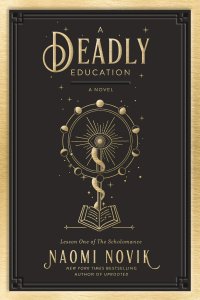Paul Di Filippo Reviews The Sacerdotal Owl and Three Other Long Tales by Michael Bishop
The Sacerdotal Owl and Three Other Long Tales, Michael Bishop (Fairwood Press 978-1933846729, $17.99, 280pp, trade paperback) August 2018
 Vividly do I recall purchasing the 1970 issue of Galaxy magazine that contained Michael Bishop’s first story sale, “Piñon Fall.” After all, I was only sixteen years old at the time, and in the midst of my own personal Golden Age of SF immersion. Liking the eerie and evocative tale, I kept an eye open for that byline, and soon was relishing his outcroppings in F&SF and elsewhere. Then in 1975 came A Funeral for the Eyes of Fire, the first of many Bishop books, and I was more deeply hooked. Eventually, as the fates willed it, Michael and I became friends and even collaborators.
Vividly do I recall purchasing the 1970 issue of Galaxy magazine that contained Michael Bishop’s first story sale, “Piñon Fall.” After all, I was only sixteen years old at the time, and in the midst of my own personal Golden Age of SF immersion. Liking the eerie and evocative tale, I kept an eye open for that byline, and soon was relishing his outcroppings in F&SF and elsewhere. Then in 1975 came A Funeral for the Eyes of Fire, the first of many Bishop books, and I was more deeply hooked. Eventually, as the fates willed it, Michael and I became friends and even collaborators.
And it is at this point that any reasonable and objective and skeptical reader of this column might ask, “Given this personal history of affection, can you still review his work honestly and critically?” My reply is: “That’s easy. All I do is apply one stringent criterion: is the work under the microscope something that would have enthralled and satisfied the sixteen-year-old Di Filippo, or one that would have caused him to hurl the book aside and say, ‘Damn it, Bishop, you’ve let me down!'” After all, no one is a harsher or more demanding–or perhaps even more perceptive–critic than an adolescent fanboy who feels that every bad story is an assault on his love for the field. So I just revert to that mindstate, my personal connections with Michael Bishop banished to some nebulous future, and dig into his prose.
Employing this stringent metric, I can confidently state that his new collection of four novellas is top-notch. The young Di Filippo would be in heaven. But this is not an unexpected conclusion, given that the book reprints four tales that have already received their share of praise from others. A volume that duplicates your library then? Hardly! Two of the stories, since their magazine appearances, have never seen the interior of a prior Bishop collection; one is an early standalone novel; and the fourth was last seen in a Bishop collection from 1986. Also, all of them have been stroked and smoothed into variant texts preferred by the author. Thus, this collection is both essential for Bishop fans and a good introduction to newbies, since the tales span a good portion of his long career, and offer much variety.
Opening the volume (after a melancholy sonnet from Bishop wearing his poet’s laurels), “The Sacerdotal Owl” is the second-newest item, from 2003. In a shorthand description, I would call this one of Seabury Quinn’s Jules de Grandin adventures rewritten by Karen Russell. It’s bonkers and subtle, pulpy and literary, and altogether unpredictable and touching.
Our heroine, Lace Kurlansky, voyages to the Central American country of Guacamayo. She is to meet her fiancé, Cabot Chessman, an archaeologist busy excavating Mayan ruins. Eccentrically, Cabot wishes to have their marriage ceremony enacted in situ. But her man is not waiting, as expected, to greet her. So instead, the stranded Lace takes up perforce with a native peddler, one Chac Sañudo. They learn that rebels have taken Cabot and crew hostage. Nonetheless, she vows to join him. En route to the ruins, Chac and Lace become lovers. But there seems to be a third person present at their union. This is merely the start of a series of mystical doings that will culminate with a voyage to the underworld and leave Lace with her whole life upended.
Bishop inhabits the soul of his heroine with compassion, humor and not a little Perils of Pauline excess. Subject to one wild escapade after another, Lace never falters nor turns to jelly. She might not have all the answers to the mysteries pummeling her, but she persists.
“And Strange at Ecbatan the Trees” saw life as a DAW book in 1977, titled Beneath the Shattered Moons, and that’s when I read it. Major chunks of the narrative have stuck with me over forty years, and I attribute that to the baroque intensity of the prose and to Bishop’s skills at delivering cinematic set pieces. As he explains in his “Afterword,” early Le Guin novels inspired him to write something of a sophisticated planetary romance, with not a few Vancian touches as well. Set on a distant world in the year 12,500 AD, the tale gives us two nations at war, with an artist protagonist who just wishes to follow his muse, but is forced to become a combatant of sorts. Gabriel Elk stages plays using corpses as technologically reanimated actors. It’s a somewhat morbid profession, but one that certainly elicits deep responses from his audience, who values his work. But when Pelagan invaders come calling, Elk must turn his skills to weaponry, and risk losing all that he values, including his son Gareth.
The young Bishop had an inspiration to tell the tale a-slant, through the first-person narration of Elk’s assistant, Ingram, and that move allowed both a Byronic distancing from Elk and also a parallel narrative about how Ingram himself reacts to the war and to his master’s quandary. This doubling of focus gives the tale a density of emotion that a lesser writer could not have achieved.
The next two stories revolve around religion, one a little less single-mindedly than the other. Bishop, a devoutly Christian writer, but a seeking rationalist as well, has always been known as one of SF’s more deity-fueled writers, along with James Morrow, Gene Wolfe, James Blish, and John Crowley. But of course, you should expect no catechisms or sermons, just sensitive, sometimes absurdist explorations of theopanies, epiphanies, and sin.
“To the Land of Snow” is set on a generation starship crewed by Buddhists intending to transmit Tibetan values across the stars and to a colony world. Our point of view is Greta Bryn Brasswell, age seven when the tale opens. Woken from suspended animation, she is informed that she is the ship’s new Dalai Lama, the current holder of that title having expired. Greta is dubious, but game. The rest of the narrative tracks her up-and-down progress, both spiritual and realpolitikal, until she is thirty-one years old and at the ship’s destination.
Having delved a bit into Tibetan Buddhism myself, I can affirm that Bishop treats the subject intelligently and with real empathy. But of course his major strokes are reserved for an unfolding of Greta’s life as she deals with the stresses of her situation. Her portrait emerges fully fleshed. Not neglected are all the other good things that traditionally accompany the generation-ship story: mechanical and mental breakdowns aplenty. Able to hold the reader’s rapt attention with a limited cast and setting is a sizable coup, and Bishop brings it off.
A giant sentient mantis is abducted from its homeworld, and on the way back to Earth becomes regarded as a new Messiah. Sure, you say, I coulda thought that one up! I doubt it. But even if possible, could you have wrought such a follow-through as “The Gospel According to Gamaliel Crucis; or, the Astrogator’s Testimony.” Delivered in the form of Bible verses, and with a suitable diction, pace and syntax, Bishop’s text follows the preachings, teachings, and excruciations of the Mantikhoros and her (yes, a female insect Jesus) apostles, Gamaliel chief among them. The whole narrative has much of the acerbic energy of a Tom Disch jape, some of the wackiness of a Monty Python film, but finally ends up as a truly compassionate and thoughtful pondering of how humanity would receive a new savior in discomfiting form, and whether we deserve one or not. Put this on the shelf right next to Stranger in a Strange Land.
Let me conclude by making a proposal that is admittedly not wholly unbiased. A few years ago I suggested that Norman Spinrad deserves a SFWA Grand Master Award, and he still does. But coeval or next in line is Michael Bishop. This book is Exhibit One.
 While you are here, please take a moment to support Locus with a one-time or recurring donation. We rely on reader donations to keep the magazine and site going, and would like to keep the site paywall free, but WE NEED YOUR FINANCIAL SUPPORT to continue quality coverage of the science fiction and fantasy field.
While you are here, please take a moment to support Locus with a one-time or recurring donation. We rely on reader donations to keep the magazine and site going, and would like to keep the site paywall free, but WE NEED YOUR FINANCIAL SUPPORT to continue quality coverage of the science fiction and fantasy field.







